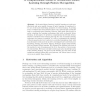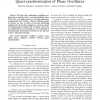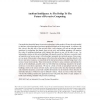26 search results - page 1 / 6 » A Computational Model of Accelerated Future Learning through... |
ITS
2010
Springer
13 years 9 months ago
2010
Springer
Accelerated future learning, in which learning proceeds more effectively and more rapidly because of prior learning, is considered to be one of the most interesting measures of ro...
TNN
2011
12 years 11 months ago
2011
—The idea that synchronized oscillations are important in cognitive tasks is receiving significant attention. In this view, single neurons are no longer elementary computational...
ISVC
2010
Springer
13 years 3 months ago
2010
Springer
In this paper, we propose an automatic learning method for gesture recognition. We combine two different pattern recognition techniques: the SelfOrganizing Map (SOM) and Support Ve...
FGR
2008
IEEE
13 years 11 months ago
2008
IEEE
One prediction about this future of pervasive technology is that people will carry the tools needed to interface with technological resources sprinkled through out the environment...
CVPR
2010
IEEE
14 years 1 months ago
2010
IEEE
Many successful models for scene or object recognition transform low-level descriptors (such as Gabor filter responses, or SIFT descriptors) into richer representations of interme...



